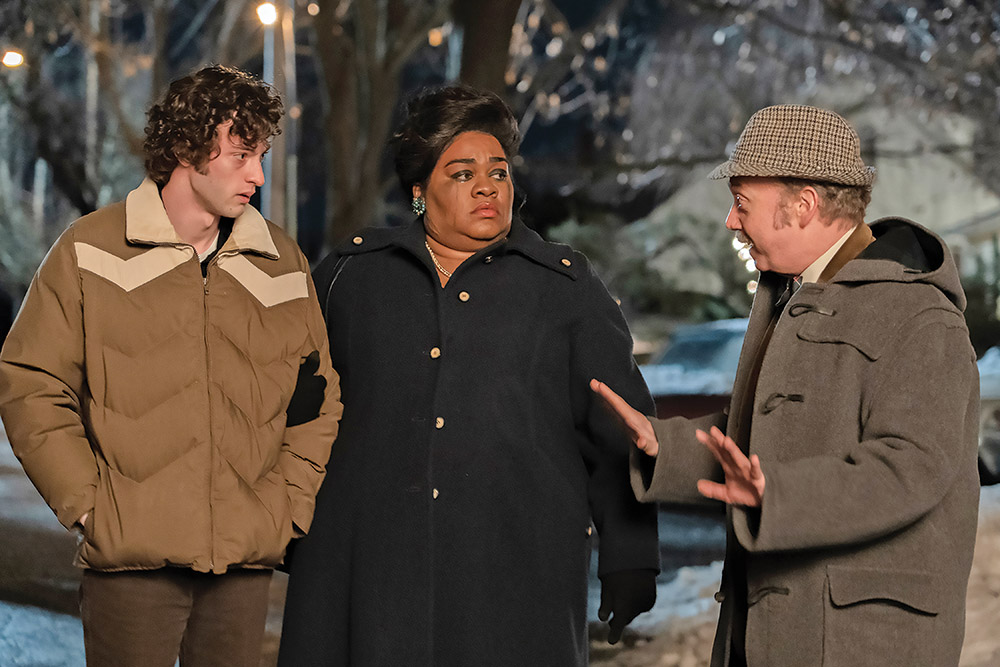
Randolph with Dominic Sessa (left) and Paul Giamatti in Focus Features’ ‘The Holdovers.’
Seacia Pavao/FOCUS FEATURES

Da’Vine Joy Randolph has played a plethora of unforgettable parts across her 10-year, steadily rising career on the stage and screen. She first burst to attention in 2012 with a Tony-nominated debut in Ghost: The Musical on Broadway; she later won plaudits with deviously funny supporting roles in High Fidelity, The Lost City and Only Murders in the Building; and her turn in The Idol was widely considered the most unambiguously excellent element of the otherwise divisive HBO drama. But for her performance in Alexander Payne’s The Holdovers, she says she was forced to change gears and radically slow down.
“This character is so different from me,” Randolph explains. “I’m the kind of person who’s everywhere all at once — I think and speak fast. But this woman has a very methodical rhythm to her, and she’s going through a moment of grief and personal devastation.”
Set in 1970, The Holdovers follows a curmudgeonly history teacher (played by Paul Giamatti) at a preppy New England boarding school, forced to chaperone a troubled student (Dominic Sessa) who has nowhere to go during Christmas break. Stuck with the teacher and the kid is Randolph’s Mary Lamb, who runs the school cafeteria and is grieving the loss of her son, recently killed in Vietnam.
“I knew I had to find and use a number of skills in order to disrupt my normal patterns and fall into the place where she lives in her body,” Randolph says of her approach to inhabiting the character.

Randolph with Dominic Sessa (left) and Paul Giamatti in Focus Features’ ‘The Holdovers.’
Seacia Pavao/FOCUS FEATURES
Her first task was to put time and research into mastering her character’s period-specific Black Boston accent. “People from Boston do not mess around,” she says. “I wasn’t just going to wing that dialect.” She also asked Payne if she could actually cook on set, rather than simulate her character’s work in the kitchen throughout the film (“I love to cook, and it just helped to anchor me into her world”). The director also believed that if the year were 1970, her character undoubtedly would have been an avid smoker. So Randolph, who had never smoked in her life, set about mastering the expressive power of casually wielding and savoring a cigarette — a task as involved as learning to convincingly sword fight on camera, she says.
“I watched a lot of Bette Davis movies to get the casual rhythms and cadence of smoking — to know when to pull when the other person is talking and how to do it with naturalism while I’m talking,” she says. “There are a lot of interesting details in how the style of smoking relates to what the smoker is going through emotionally in that moment — it was a whole learned practice.”
Most of Randolph’s scenes are opposite Giamatti, and early on they realized they “really lucked out” because they had received the same formal training (MFAs from the Yale School of Drama). “It was like we had this shorthand, where lots of things didn’t even need to be said, so we could deepen everything even more, which was very exciting,” she says.
The intimate, somewhat unspoken bond that forms between the characters — against the odds and despite their radically different circumstances in life — is central to the film’s culminating themes.
“These are three people who have all been othered in one way or another, and no one has ever really stopped to listen to them,” Randolph says. “Due to this circumstance of being stuck together at the neutral ground of the school, they’re each able to let their defenses down — and these three broken people are able to help one another. I just loved this idea that you don’t have to be perfect or have everything together to make a positive impact on someone. You just have to have empathy — and you build community where you can find it.”
This story first appeared in a December standalone issue of The Hollywood Reporter magazine. Click here to subscribe.